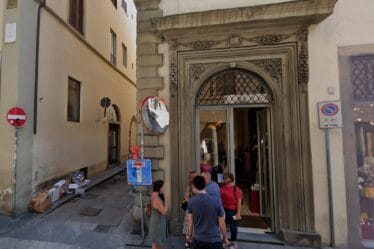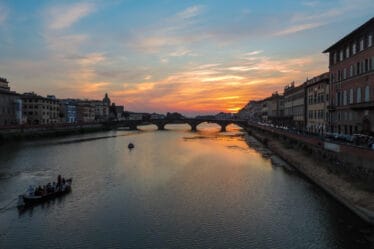

Introduction: A Masterpiece Beneath the Altar
In the heart of Florence’s architectural wonder, Santa Maria del Fiore, lies a hidden treasure that embodies faith, art, and history: San Zanobi’s Sacred Urn. Located beneath the high altar of the apse, this magnificent funerary monument preserves the remains of Florence’s first bishop, Saint Zenobius (San Zanobi).
Designed through a public competition and entrusted to the genius of some of the greatest Renaissance artists, the urn stands as a tribute to sacred memory and artistic excellence. San Zanobi’s Sacred Urn is not only a resting place, but a symbol of Florence’s devotion and creative spirit.
Part 1: The Origins of a Sacred Commission
The idea for the urn emerged in January 1431, when Filippo Brunelleschi and the cathedral’s master builder were tasked with creating a design for a new altar in the apse. Construction began just two months later. However, it was in 1432 that a pivotal moment occurred: a public call for the creation of San Zanobi’s sepulcher was posted at the Palazzo dell’Arte della Lana and at the guild of the Maestri di Pietra e Legname.
Artists from all over Florence were invited to participate. Among them, the renowned Lorenzo Ghiberti was chosen—already famous for his incredible bronze doors of the Baptistery. The primary element of the urn was cast using surplus bronze originally intended for the statue of Saint Stephen at Orsanmichele.
This early Renaissance period saw many such artistic contests, fostering innovation and excellence. Learn more about Renaissance sculpture contests in Florence here.
Part 2: The Design and Symbolism of San Zanobi’s Sacred Urn
Measuring 85 by 193 cm, the urn is a masterpiece of bronze sculpture, adorned with intricate bas-reliefs that recount episodes from the saint’s life. The central panel portrays the miracle of the resurrection of a French woman’s son in Borgo degli Albizi. On either side, two more miraculous resurrections are depicted: one of Saint Ambrose’s servant, and another of a young boy struck down by an ox-drawn cart.
On the reverse side, six angels hold up an elm-leaf garland, within which sits a solemn Latin inscription:
CAPUT BEATI ZENOBII FLORENTINI EPISCOPI IN CUIUS HONOREM HEC ARCA INSIGNI ORNATU FABRICATA FUIT
This epitaph, meaning “The head of Blessed Zenobius, Bishop of Florence, in whose honor this richly adorned urn was made,” is believed to have been penned by the famous humanist and chancellor Leonardo Bruni.
Explore more about Leonardo Bruni and his influence on Florentine culture here.
Part 3: Materials, Completion, and Enduring Legacy
The construction of San Zanobi’s Sacred Urn required immense resources:
- 3,277 pounds of brass
- 330 pounds of wax
- 122 pounds of copper and iron
Although the monument was structurally completed in 1442, the final touch came in 1590, when Vittorio di Pellegrino dell’Ancisa financed its gilding. Unfortunately, the gold layer did not endure—likely due to ineffective gilding techniques of the time.
Today, even without its original gold sheen, the urn continues to shine as a testament to religious reverence and artistic achievement. Visitors to Florence Cathedral are often captivated by its emotional depth and visual storytelling, reminding us of the timeless connection between spirituality and creativity.
Discover more about San Zanobi and his miracles on the official Florence Cathedral website.
Conclusion: Art, Faith, and Memory United
San Zanobi’s Sacred Urn is more than just a tomb. It is a powerful symbol of Florence’s Renaissance spirit, merging sacred devotion with the highest levels of artistic excellence. Through its detailed bronzes, miraculous stories, and enduring history, the urn continues to inspire wonder in all who behold it.
For travelers, historians, and art lovers alike, San Zanobi’s Sacred Urn remains a hidden masterpiece worth discovering.



